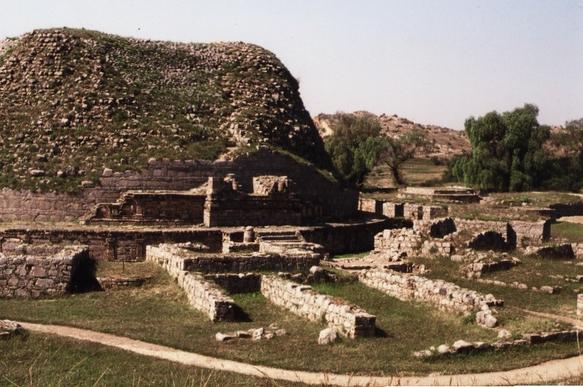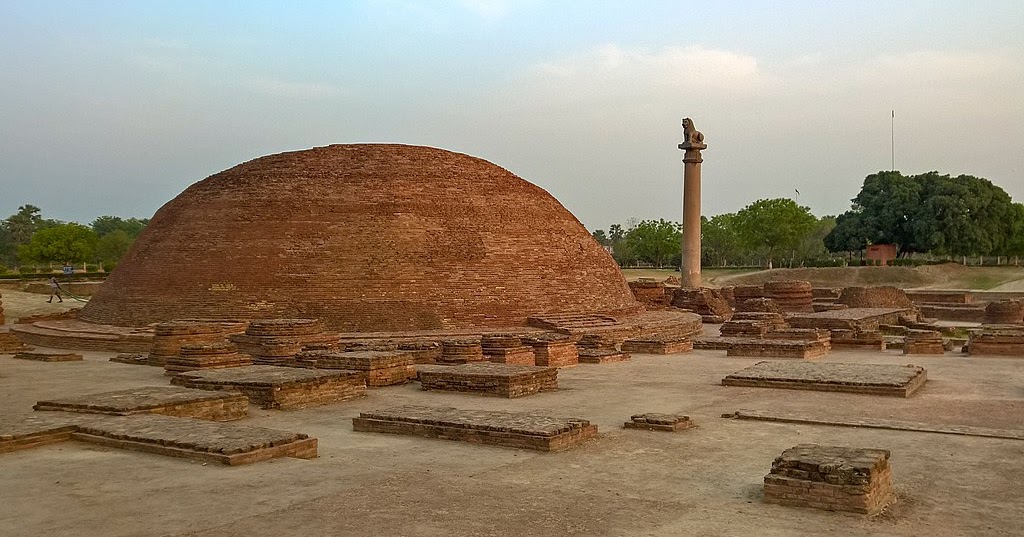600 BC was the age of the emergence of bigger political entities known as Mahajanapadas. The contemporary source such as the Buddhist text Anguttaria & Jain text Bhagatisutra provides the name of 16 Mahajanapadas of 600 BC. The emergence of these Mahajanapadas was facilitated by several favorable, politico-eco-military socio-cultural factors.
The tradition of territorial expansion which commenced in the Later Vedic Age transformed Janas of the Rig-Veda age to Janapada. It was this tradition that transformed Janapada – Mahajanapadas by 6 Century BC. The use of iron weapons played important role in Mahajanpada because these weapons greatly strengthen the imperialistic outlook. The powerful army using iron weapons used for territorial expansion.
Religious ideas & ceremonies inspired rulers to peruse policy of territorial aggrandizement as a result of which the size of political entities continued to expand. Progress witnessed in agriculture, prepared a strong material base for the emergence of Mahajanpada. As a result of this economic progress king in a position to maintain & elaborate administration.
Population growth also played important role in Mahajanpada. Most of Mahajanpada of 600 BC was monarchical in tradition, out of 16 Mahajanpada, Vajji & Malla were republics. Aggressive leadership also contributed to the emergence of Mahajanpada because kings like Bimbisara used all possible strategies for territorial expansion.
In 600 BC monarchy & republic were equally successful. The Vajji confederacy renounced for his strength but with time the republic disappeared from the scene of history & only monarchy left behind. Lack of unity between decision-makers in the republic state played. Colligate form government was followed in Republic states decisions were taken by the big council through majority votes.
They couldn’t stand together during hours of crisis & they’re international different exploited by the powerful monarchy. Geography location – Disadvantageous because they are located in foothills & remote tribal areas where extensive fertile plains and another economic resource absent. S. Sharma conservative in outlook maintained limited contained with other areas. As a result, the republic couldn’t develop new weapons available with the monarchy. The aggressive expansionist policy of rulers like Ajatshatru, Mahapadamnanda, Chandragupta Maurya, and Samudra Gupta destroyed many R.S. Sharma.
Magadha

Magadha was one of the most prosperous kingdoms of ancient India and one of the most prominent ‘Mahajanapadas.’ For many years, Patliputra was the capital of Magadha. The kingdom was bounded by the Ganges in the north, river Champa in the east, and river Son in the west. According to ancient texts, Brihadratha was the earliest known ruler of Magadha. The kingdom was also ruled by King Bimbisara, under whom Magadha flourished. Great Indian empires including the famous Maurya Dynasty originated in Magadha. Gautama Buddha spent much of his life in Magadha; hence the region is believed to hold great significance to Buddhists.
Gandhara

According to Hecataeus of Miletus, Purushapura or present-day Peshawar served as a grand Gandharic city. Other references about Gandhara have been made in ancient texts like ‘Rigveda,’ ‘Ramayana,’ and ‘Mahabharata.’ This great kingdom was served graciously by river Indus and its capital Taksashila (Taxila) housed the renowned center of learning, the ‘Taksashila University.’ Scholars came to the university from all over the world to seek greater knowledge and wisdom. Though Gandhara was a huge kingdom on its own, it is often considered to be a part of an empire by modern-day scholars.
Kamboja
The state of Kamboja is referred to as a republican in several ancient scripts. These scripts also state that there were two Kamboja settlements, a theory that is backed by modern-day historians. It is said that ancient Kamboja was located on either side of the Hindukush mountain range. But clans of Kamboja are believed to have crossed the mountain range to plant colonies on the southern side as well. These clans of people are associated with the Gandharas and Daradas and find mention in many Indian texts, including the Edicts of Ashoka the Great.
Kuru
At the time of the Buddha, Kuru was ruled by Korayvya, a titular chieftain. Its capital was Indraprastha (present-day Delhi), which was known for people with sound health and deep wisdom. The Kurus were related to people of other communities like the ‘Panchalas’ and the ‘Yadavas’ as they had matrimonial relations with them. Though the Kuru kingdom was a well-known monarchical state in the ancient world, the 6th and 5th centuries BCE saw the formation of a republican form of government in the land of Kuru. Kautilya’s ‘Arthashastra,’ which was written in Sanskrit in the 4th century BCE, also states that the Kurus followed the king consul constitution.
Kosala
The kingdom of Kosala was located close to the kingdom of Magadha. With Ayodhya as its capital, Kosala was bound by the river Ganges in the south, river Gandak in the east, and the Himalaya mountains in the north. According to Vedic texts, Kosala was the biggest and most powerful kingdom ever in history. At the time of the Buddha and Mahavira, the Kosala kingdom was ruled by King Prasenajit. After a series of tactical moves for supremacy by Kosala and Magadha, the kingdom of Kosala was eventually merged with Magadha, when Kosala was being ruled by Vidudabha.
Malla
The Mallas of the Malla kingdom is often described as powerful people who dwelled in Northern South Asia. Many Buddhist texts refer to the kingdom as a republican dominion made up of nine territories. Like Kuru, Malla kingdom too had monarchical forms of government, but later moved towards the republican form of government. Ancient cities like Kusinara and Pava, which belonged to the Malla kingdom, are considered extremely important by Jains and Buddhists. While Lord Mahavira had his last meal at Kusinara, Gautama Buddha had his last meal at Pava. Both Kusinara and Pava are believed to have hosted Buddha for a long period of time.
Panchala
The Panchala kingdom was located east of the Kuru kingdom, between the river Ganges and the mountain ranges of the Himalayas. Panchala was divided into two parts, namely Dakshina-Panchala and Uttara-Panchala. While Adhichhatra (present-day Bareilly) served as the capital city of Uttara-Panchala, Kampilya (present-day Farrukhabad) was made the capital of Dakshina-Panchala. Originally a monarchical kingdom, Panchala is believed to have turned into a republican dominion during the 6th and 5th centuries BCE. Kautilya’s ‘Arthashastra’ also states that Panchala followed the king consul constitution. The kingdom was later annexed by the Mauryan Empire and then by the Gupta Empire.
Matsya
Located south of the Kuru kingdom and west of the river Yamuna, the Matsya kingdom was founded by an Indo-Aryan tribe of Vedic age. Apart from serving as the main water source, Yamuna also separated the Matsya kingdom from the Panchalas. Viratanagara (present-day Bairat), which was named after the kingdom’s founder Virata, was Matsya’s capital. According to ancient texts, a king named Sujata ruled over Matsya as well as Chedi, which later became a separate kingdom. Though Matsya is mentioned as one of the ‘Mahajanapadas’ in various Buddhist texts, its political power had greatly dwindled by the time of the Buddha.
Chedi
The kingdom of Chedi finds great prominence in the Hindu epic Mahabharata. According to the ancient text, Chedi was ruled by a king named Shishupala, who was an ally of the kings from Magadha and Kuru. A city named Suktimati has been described as the kingdom’s capital. Though the exact location of modern-day Suktimati has not been figured out yet, prominent historians like F. E. Pargiter and Hem Chandra Raychaudhuri say that the ancient city might have been established near present-day Banda in Uttar Pradesh. An Indian archaeologist named Dilip Kumar Chakrabarti has claimed that the ruins of a historical city near the outskirts of Rewa in Madhya Pradesh may unlock further details about the kingdom and its capital city.
Anga
The earliest references to the people of Anga are made in the ‘Atharva Veda,’ which describes the Angas as despised people. The ‘Jain Prajnapana’ claims that Angas was among the earliest groups of Aryan people. Over a period of time, the kingdom of Anga became a great center of trade, attracting merchants from the neighboring kingdoms. Anga and its rival Magadha were separated by river Champa, which served as the main water source for both the kingdoms. Anga was eventually annexed by Magadha in King Bimbisara’s only conquest.
Avanti
Post Mahavira and Buddha, the kingdom of Avanti was considered as one of the four great monarchies along with Kosala, Magadha, and Vatsa. Apart from serving as the kingdom’s principal source of water, river Narmada also separated Avanti into two parts – North Avanti and South Avanti. However, North and South Avanti were integrated at the time of Buddha and Mahavira, during which Ujjaini served as the common capital of the integrated kingdom. Avanti was a great center of Buddhism. When King Shishunag defeated Nandivardhana, Avanti became a part of Magadha.
Vatsa
Vatsa or Vamsa, which was located near the present-day Allahabad in Uttar Pradesh, thrived under a monarchical form of government. King Udayana of the 7th century BCE ruled Vatsa with Kosambi as its capital. Though Udayana initially opposed the teachings of the Buddha, he became a follower of Buddha later in his life and even made Buddhism the state religion of Kosambi. Vatsa’s capital city attracted several wealthy merchants, who made Kosambi their home. Kosambi was also a prominent Centerport of passengers and goods, coming in from the south and north-west.
Assaka
The Kingdom of Assaka was located in southern India. Apart from serving as the kingdom’s principal source of water, river Godavari separated Assaka from Mulaka, which was also known as Alaka. It is said that Mulaka was once a part of Assaka. According to Buddhist texts, King Brahmadatta ruled over Assaka with its capital at Potali (present-day Maharashtra). Assaka is described as one of the 16 ‘Mahajanapadas’ in an ancient Buddhist text known as ‘Anguttara Nikaya.’
Surasena
The kingdom of Surasena was located to the west of the river Yamuna and the east of the Matsya kingdom. Surasena played an important role in propagating Buddhism as the king of Surasena, Avantiputra, was among the earliest known chief disciples of Buddha. During the time of Megasthenes, Mathura, the capital of Surasena, was known as a city where worshipping Krishna was considered prominent. The kingdom of Surasena, which once flourished, was later annexed by the Magadhan Empire.
Vajji

Vajji was one of the most prominent ‘Mahajanapadas’ of ancient India. Vajji finds mention in the Jaina text ‘Bhagavati Sutra’ and in Buddhist texts like ‘Anguttara Nikaya.’ Vajji was located towards the north of the river Ganges and was bound by river Gandaki in the west. Apart from serving as Vajji’s chief source of water, the river Gandaki is believed to have played a key role in separating Vajji from Malla and Kosala as well. Apart from Vaishali, which was its capital city, Vajji also housed popular ancient cities like Hatthigama, Bhoganagara, and Kundapura.
Kashi
Ancient Kashi was bound by river Varuna in the north and river Assi in the south. The Kingdom of Kashi, which had its capital at Varanasi, was the most powerful among ‘Mahajanapadas’ before the time of the Buddha. Several ancient texts speak highly of Kashi, which was one of the most prosperous kingdoms during its heyday. Hence, Kashi was in constant conflict with the kingdoms of Kosala, Magadha, and Anga, which were trying to annex Kashi. Though Kosala was once defeated by Kashi, it was later annexed by Kosala under the rule of King Kansa, who ruled at the time of Buddha.

